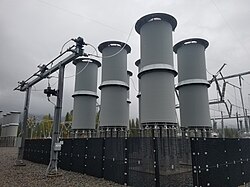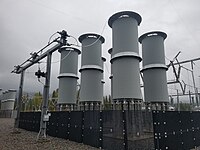Tag:compensator=shunt_reactor
| Description |
|---|
| A coil intended to compensate for capacitive current, branch connected to a network edge |
| Group: power |
| Used on these elements |
| Useful combination |
| Status: approved |
| Tools for this tag |
|
A ![]() shunt reactor (421-01-03) is an electrical power system component, commonly found in substations, consisting of a coil (an inductor) connected between the phase and ground.
shunt reactor (421-01-03) is an electrical power system component, commonly found in substations, consisting of a coil (an inductor) connected between the phase and ground.
Shunt reactors are used to counteract the effects of parasitic capacitance in power lines, which helps to regulate the voltage of the system. They can be found as both single-phase and three-phase versions.
A shunt reactor is different from a series reactor, which is connected in line with the current.
Possible confusion with power transformers
Oil-filled shunt reactors have a similar physical appearance to transformers, so some care must be taken to identify them. A three-phase shunt reactor will generally only have 3 or 4 visible terminals, compared to 6 for a three-phase transformer.
How to map
First of all, please refer to general guidelines on power=compensator.
A shunt reactor may be composed of several independent devices, called a set, serving each phase of a multi-phase power line. In such situations, it is possible to map the reactors set on a single node and adding cables=*, just like power=switch. It is also possible to use as many nodes as cables and connect them accordingly.
Examples
| Photo | Location | Tagging | Note |
|---|---|---|---|
 |
USA |
One Three |
A set of 3x2 coils connected phase to neutral as to compensate capacitive current in a 220000 volts power switchgear. Each phase is composed of two coils and come from the back (in the picture).
The neutral point is on the foreground and connects each coils. Thus it's clear it's not a series reactor and it is branched to the switchgear, with a dedicated bay. |
 |
Austria |
|
This shunt reactor looks like a power transformer but is not. Only one 3-phase terminal, a ground and no power forward: it's definitely a shunt reactor.
These reactors can also be variable and have a min/max rating. |
